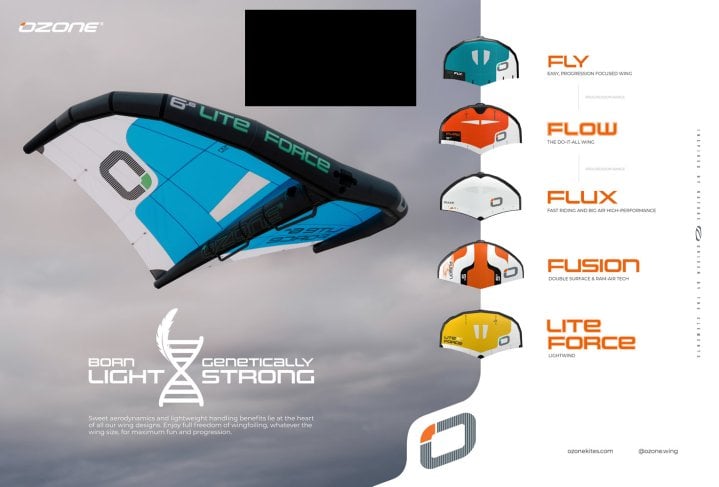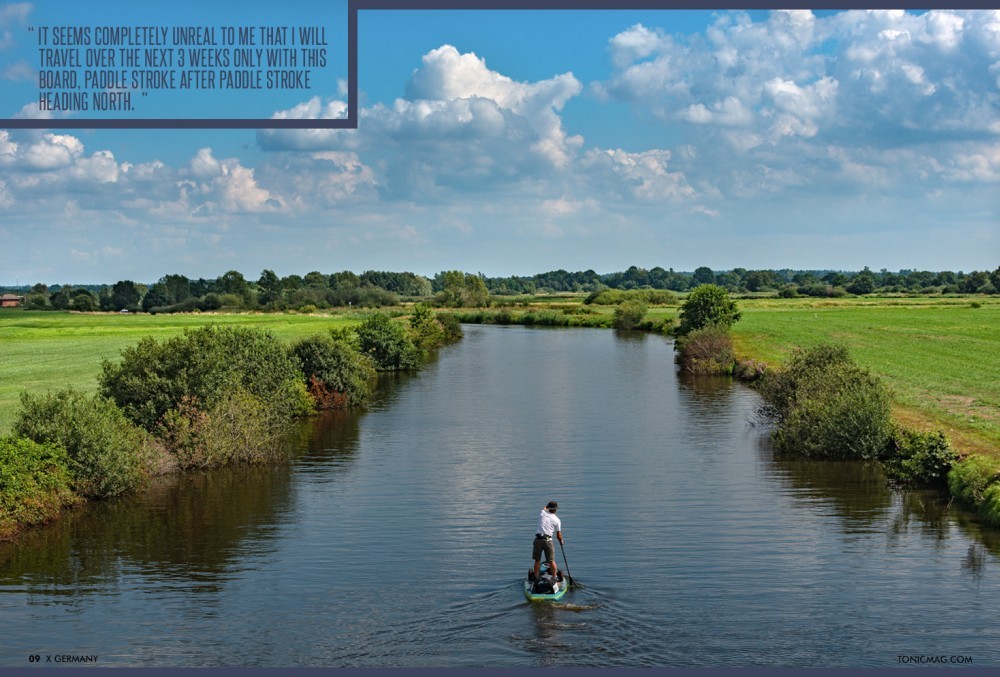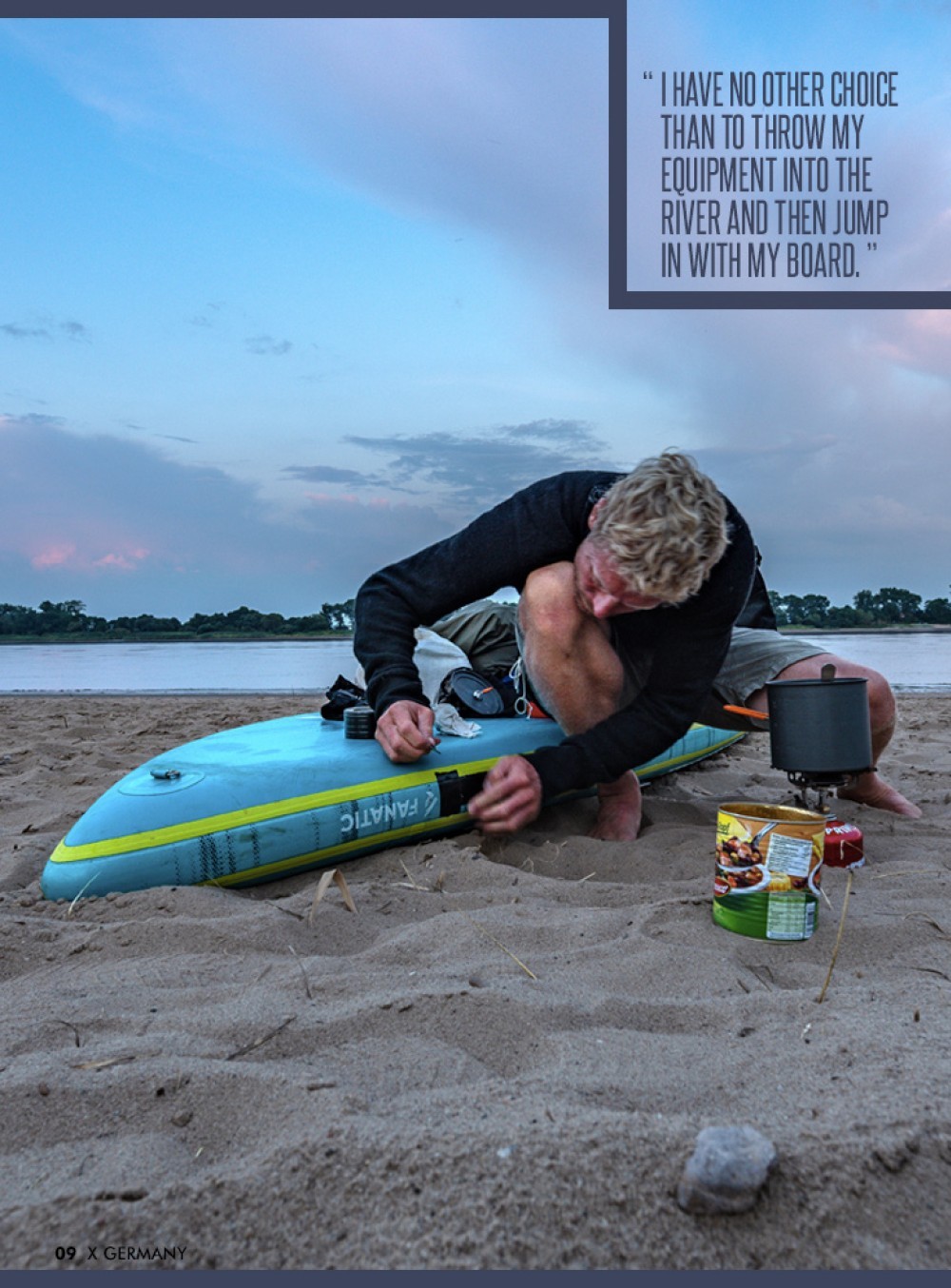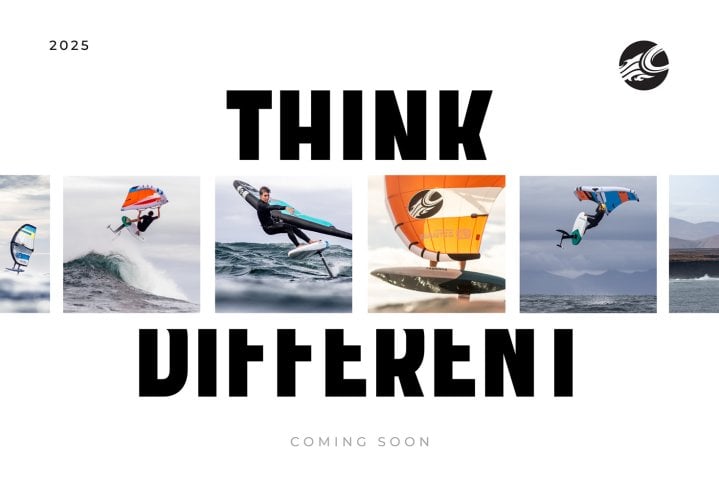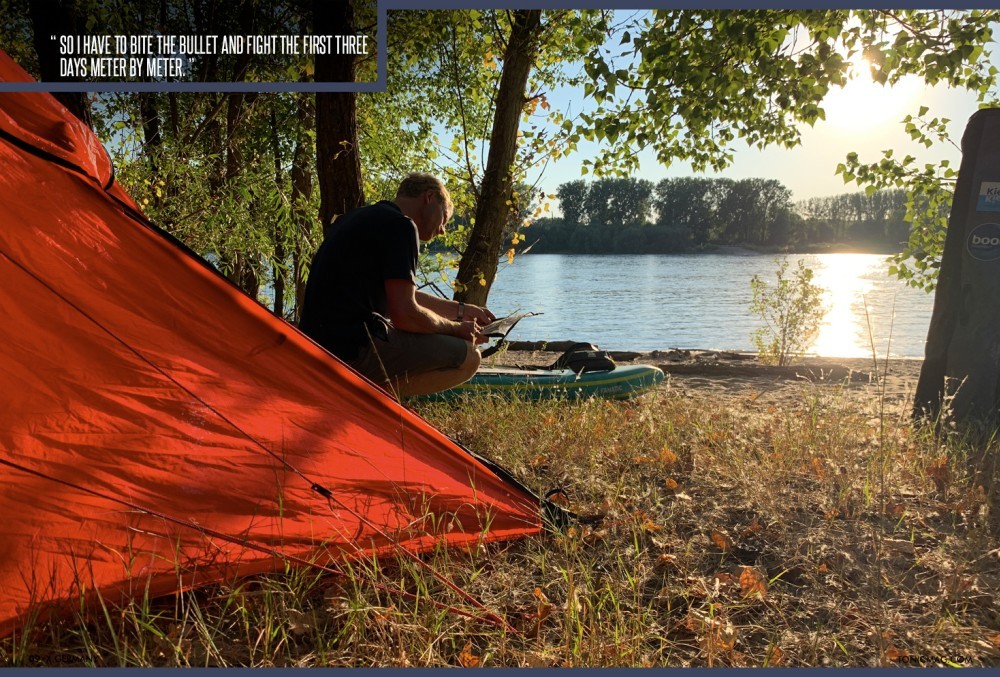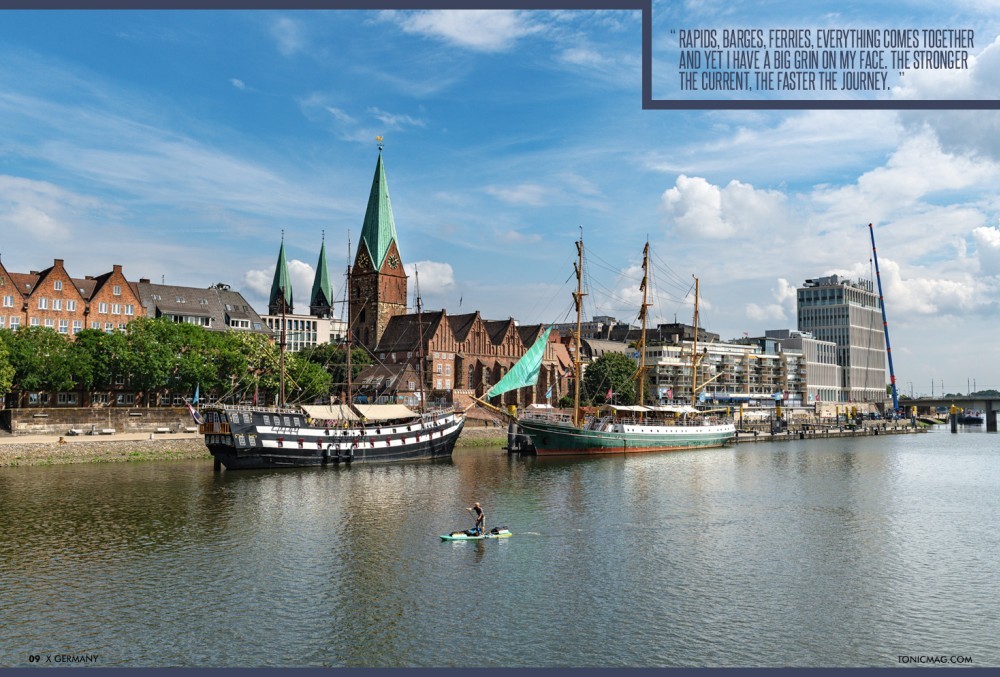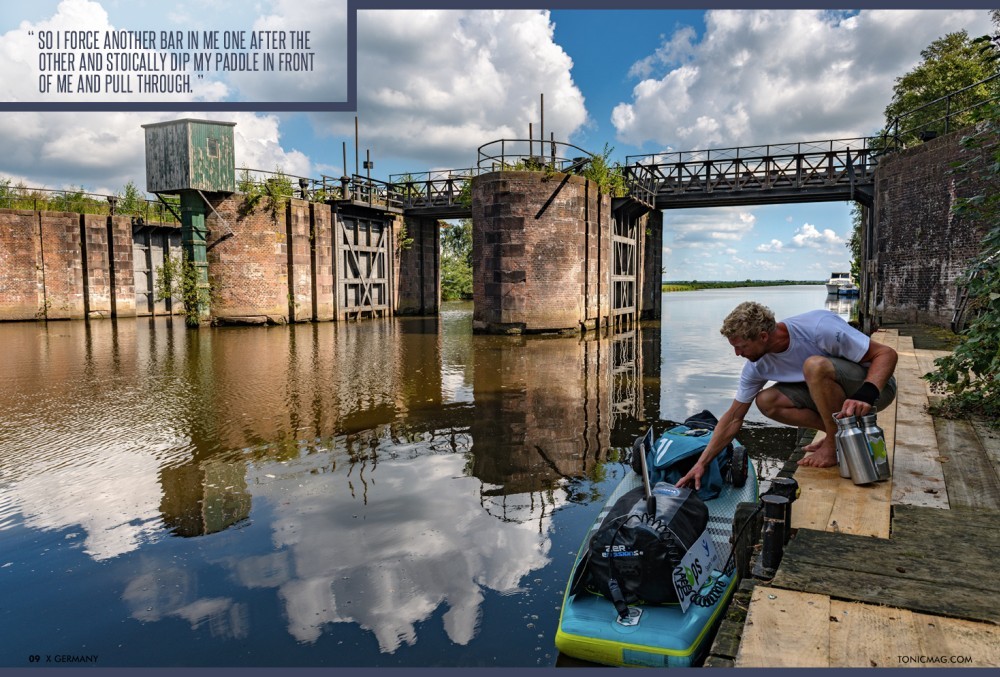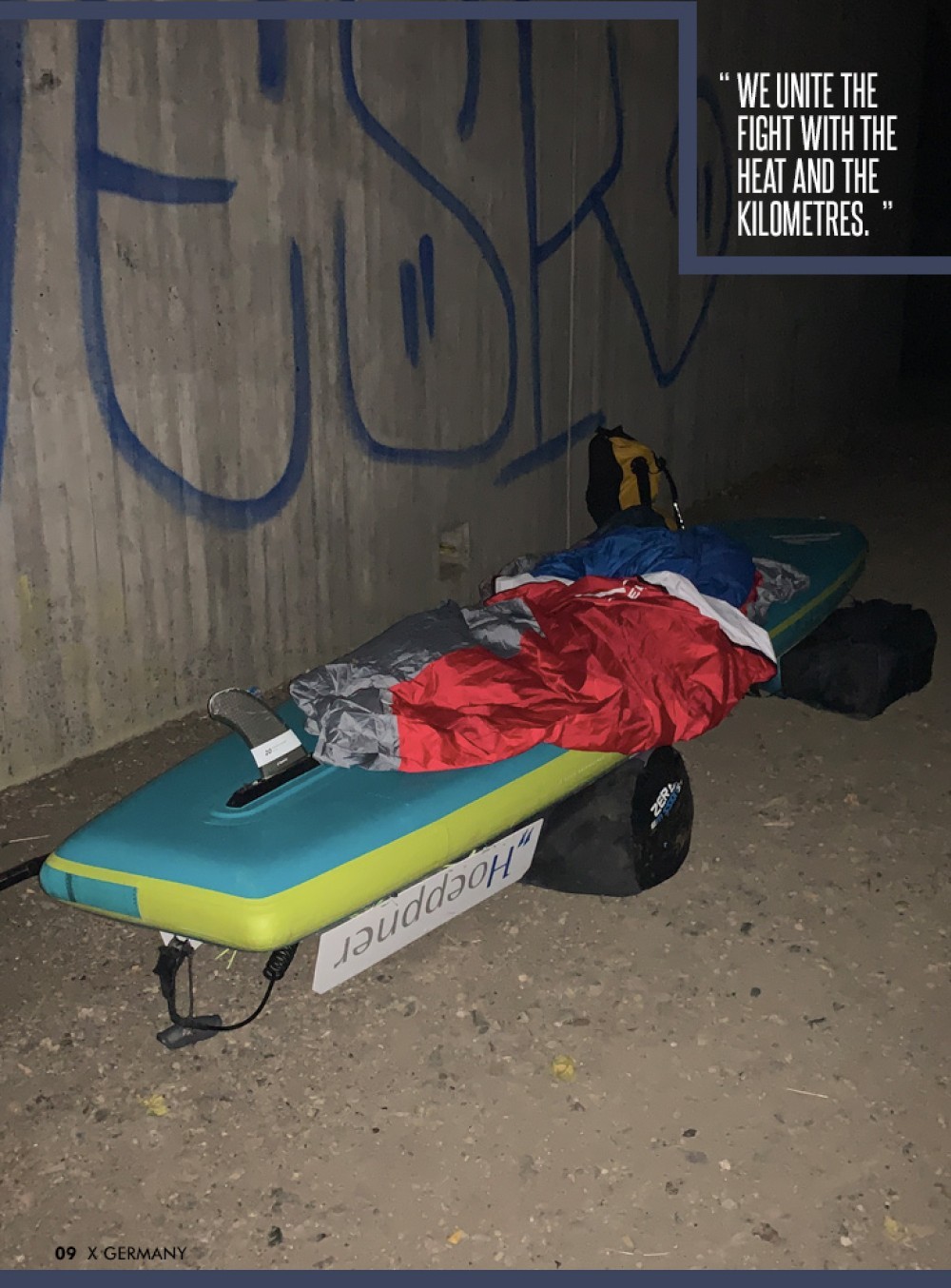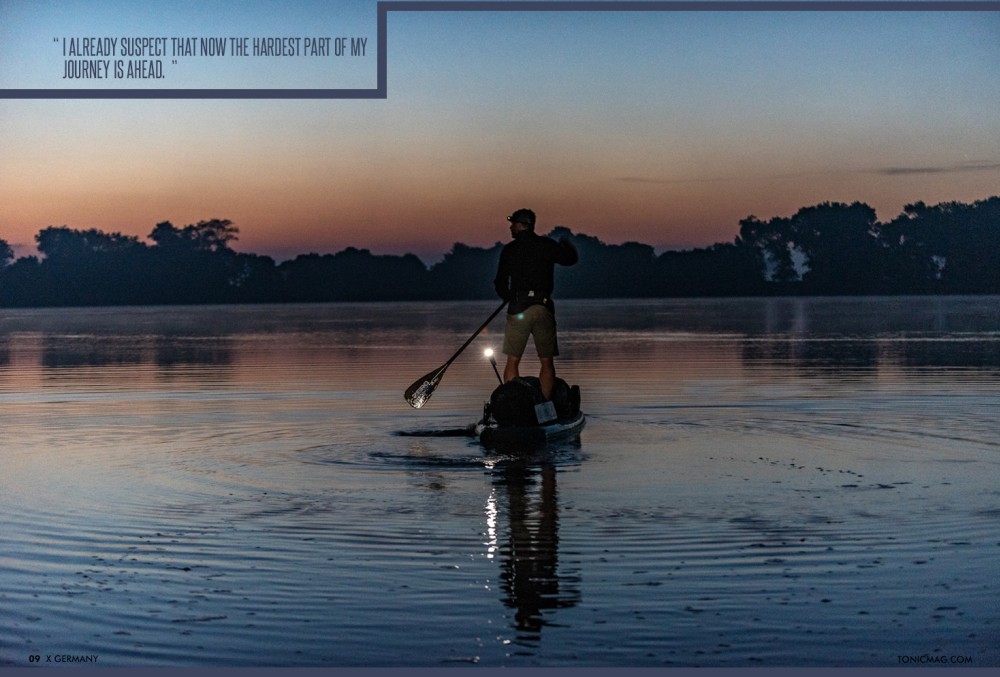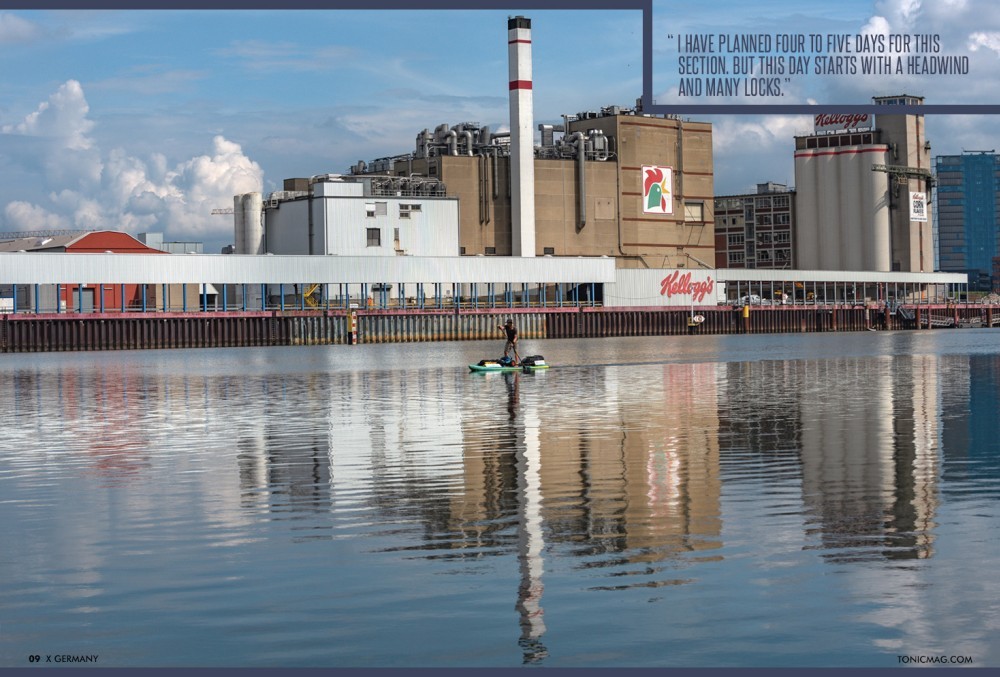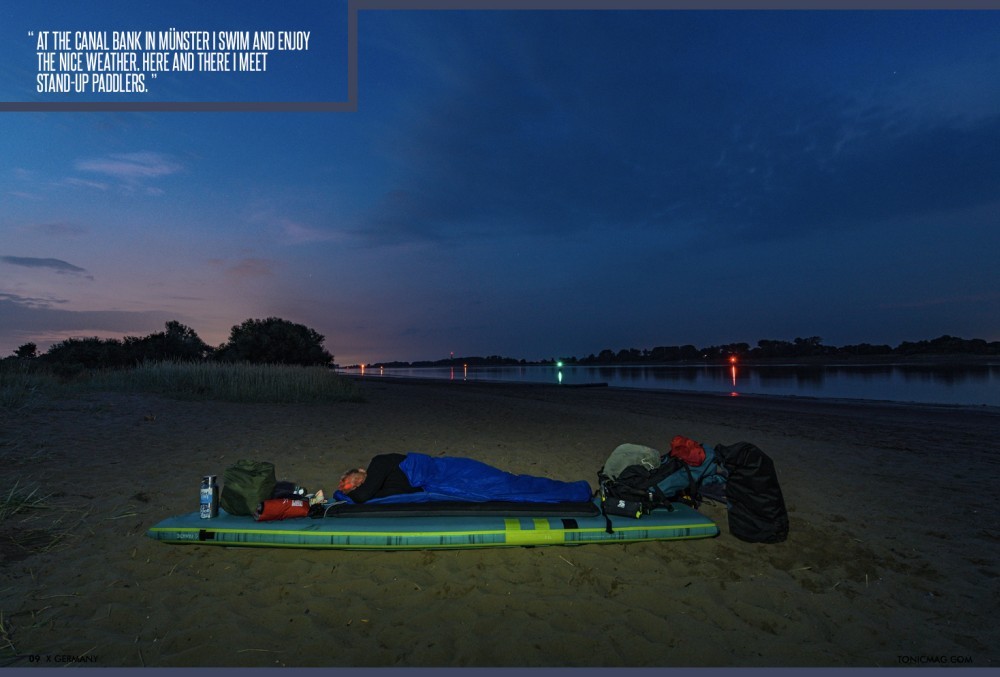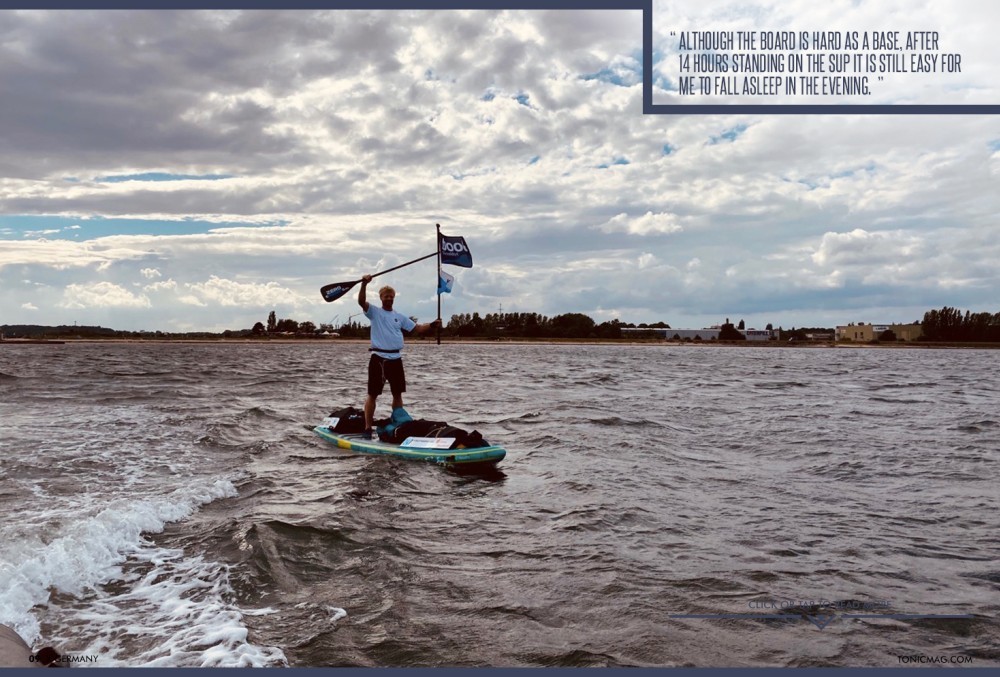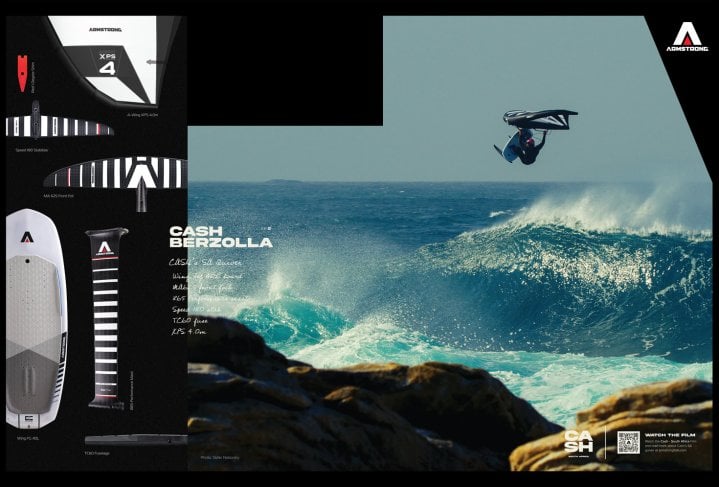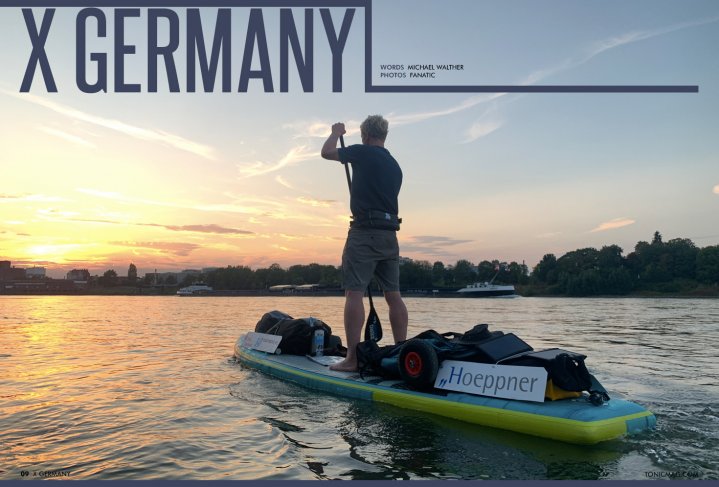
X Germany
Issue 9 / Tue 17th Aug, 2021
Michael Walther had a vision - to travel across Germany using zero emissions. Read on to discover the incredible story of his 3 week long paddle on his Fanatic board from Kiel to the Baltic Sea, an enormous distance of 1300 kilometres!
Michael Walther had a vision - to travel across Germany using zero emissions. Read on to discover the incredible story of his 3 week long paddle on his Fanatic board from Kiel to the Baltic Sea, an enormous distance of 1300 kilometres!
The flashing blue light of the water police emerges from the drizzle. With a good 15 knots they approach my heavily loaded SUP. Two uniformed officers stand on deck and instruct me in a friendly but determined manor to leave the channel. I don’t understand this world. How could I be so close yet so far?
My journey across Germany begins in Kiel. With two waterproof bags and the board backpack heavily loaded, I board the train that will take me to my starting point. Basel is the southernmost point of my journey, here I launch my 13'6 foot Fanatic Ray Air Explorer on the Rhine at 9am on August 2nd. Directly at the Wettsteinbrücke I set off, 1300km to Kiel lie ahead of me, my board and my 45kg of luggage. I limited myself to the bare essentials, but with my small boat trolley, stove, food, 6 litres of water and technical equipment, it all adds up.
The start goes according to plan. Despite a small delay on the Austrian night train I am on the water at 9 o'clock to start my journey. It seems completely unreal to me that I will travel over the next 3 weeks only with this board, paddle stroke after paddle stroke heading North. If I had known about the challenges that awaited me, I would probably have gotten back on the train home. Unsuspecting, however, I set off for the first few meters. The Rhine has a current and pushes me 6km to the North, to the first weir in Märkt.
Frequently I was asked before my tour, when I would like to be where and whether I have already selected sleeping places. I do not know the individual weirs and their transfer possibilities and so I could not estimate the amount of time each of these 35 obstacles would take on my journey. Accordingly, nothing was planned and I decided spontaneously. The exit to the first wier is easy but the re-entry into an old arm of the Rhine is not. With all of my equipment it goes down a 4m high stone bank before then a final 1m drop to the water. I have no other choice than to throw my equipment into the river and then jump in with my board. Paddling I collect my seven things, before they go any further. I have a bad feeling when I think that this is only the first transfer point on my journey.
But the following kilometres are really fun. This oxbow is the only one with current and some passages even have level 1 white water. The board is well loaded in the water with 45kg of luggage and my 90 kilos and works its way safely and stably through the rapids. Thanks to my map, I can roughly estimate which areas are passable and which I have to portage around despite the stable board. Other than the first weir, most of the following portages are well signposted and passable except for slippery algae. Cheerfully and with good average speed I fly through the first 70 kilometres to the North. However, I quickly realise that the first kilometres were an exception. Of course I knew by travel reports of other paddlers that the Southern range has hardly current to exhibit, but already 1 to 2 km/h help noticeably - both the average speed and the motivation. So I have to bite the bullet and fight the first three days meter by meter. I always set up my night camps where the shore area appeals to me. The first one is directly at a weir. If I have to get out of the water anyway, I use the interruption immediately for the night's rest. On the second day I end up soaked by 5 hours of continuous rain in combination with a thunderous hailstorm at a campsite near Strasbourg. In order not to catch a cold right at the beginning, I dry myself here and try to give my equipment the same attention. Solar panel and powerbank should keep my smartphone and my Livetracker alive over the 3 weeks. Nothing would be more annoying than if the technical equipment would stop working in the second night.
In the middle of the third day I reach Iffezheim and with it the free Rhine. From here on the river flows unrestricted to Duisburg and further. So from here on it also has it's real current and that gives me a lot of pleasure right at the beginning. The whirlpools at groins and the fairway buoys are impressive and demand full attention. The barge traffic is strong and in combination with jet skiers, water skiers and sport boats it is a mixture that demands my attention every second. Nevertheless, I manage 100 kilometres in each of the following two days, despite temperatures beyond 35 degrees Celsius. Speyer, Mannheim and Mainz fly by. The current pulls along well. So that this carries me along I must paddle each minute. If I pause, the current runs largely unused under the board. So the journey goes fast, 10 to 12 hours with full concentration on the SUP are nevertheless a challenge.
From Rüdesheim the game changes again. Here the Rhine bends to the North and accelerates again through the narrow valley. Rapids, barges, ferries, everything comes together and yet I have a big grin on my face. The stronger the current, the faster the journey. It is extremely exhausting, I rarely eat or drink enough & I come to notice the effects of this in the following days. I rush past the Loreley and play with the idea of spending a night at a campsite once again. A shower and a quiet night in the tent instead of on the hard board just appeals very much. Quickly I look for appropriate places with the smartphone and call them off to make sure that they can still fit me in. Unfortunately, the first places are occupied and the last place closes at 8pm. Still 2 hours for 17 kilometres. With a raceboard well doable, with a touring board and 45 kg luggage a real struggle. The current helps but I have no choice but to add two hours of sprinting to the end of the 11 hour day. Completely exhausted I reach Spay at 19:45.
The sixth day of my trip I want to start after the stress a little quieter and therefore sleep until 8 o'clock. More recovered but already at 28 degrees celsius I get in at about 10 o'clock and begin to work slowly past Koblenz towards Bonn. The sun rises higher, the temperatures rise and as a North German boy the sweat drips down me in streams. Every hour I sit on the board for a five minute break, apply new sunscreen, by now a thick white layer covers me, drink an energy bar and on it goes on. Slowly I realise that all protein, energy, power or other bars must be from the same ingredients. Everything tastes the same. Fig, date, grains, everything is sweet, sticky and without really surprising the taste buds. So I force another bar in me one after the other and stoically dip my paddle in front of me and pull through. The kilometres wander by, every now and then rowing boats overtake me, but then they are surprised that I overtake them again during their breaks. The continuity brings me forward. At 5 kmh paddling speed I can't compete in any race, but if I paddle for 12 hours I can do 60 kilometres a day, plus the current.
Unfortunately, the heat before Bonn effects me so much to create that I give up at 16:30 and look for a night camp. I flee into the shade and meet a cyclist who is on the way to Marburg. We unite the fight with the heat and the kilometres.
In order not to repeat a previous mistake, I start the following day at 5:30 am. In the morning I reach Cologne, paddle past the cathedral and continue. Shortly before Düsseldorf it becomes so unbearable again that I take a 3-hour lunch break in the shade. In a local café I drink four non-alcoholic Weizen within an hour. In the evening it cools down, I tick off more kilometres towards Düsseldorf and sleep about 4 meters away from the Rhine on my board on the beach.
Dusseldorf is a highlight for me. I'm thrilled when I catch sight of the TV tower and the team of the world's largest water sports fair Düsseldorf is already waiting for me. Since I was part of an advertising campaign for Boot in 2015 to 2017, I have been closely connected to the show and the team. Every year we work closely together to make Boot Düsseldorf even more exciting and I am very happy to see the familiar faces on the shore. After a short stop, I continue on my way, I want to finally get the Rhine behind me. So we arrange to meet for dinner, to which I will arrive later by train, and I go my way for now.
Around noon, I reach the Rhine Orange in Duisburg. Here the Ruhr branches off, which after a few kilometres leads into the Rhine-Herne Canal. Right here I leave the Rhine slightly wistful. Now I have almost half of my kilometres behind me but I already suspect that the Rhine kilometres were relatively easy to work out thanks to the current. What lies ahead of me now are the canals to Minden, over which I would like to reach the Weser. As is the nature of canals, these offer no current, lead almost endlessly straight ahead and I already suspect that now the hardest part of my journey is ahead. How much I will be right I notice already on the meters to Oberhausen. At the Oberhausener Kanu Verein I want to make my first stop at the canal to set off from there to my evening meeting in Düsseldorf. The 8.2 kilometers on the Rhine-Herne Canal drag on and so I reach the clubhouse only around 4pm. I am very warmly received here. Coffee and cool drinks make the rounds and within 5 minutes I feel like home. Shortly after I jump under the shower and then leave for the evening.
Day 10 starts at 6 o'clock. Dirk Jansen, the boathouse keeper says goodbye to me at the pier and paddle stroke by paddle stroke I start my 250 km long journey to Minden. There it should go on the Weser, which promises finally again a little current. I have planned four to five days for this section. But this day starts with a headwind and many locks. Every meter is hard fought for. Shortly before Datteln a thunderstorm is coming up behind me. Shortly before it reaches me, the east wind breaks down and a strong southwest wind pushes me past the new coal-fired power plant.
This new coal-fired power plant looks quite respectable. Packaged in a shimmering blue robe, it looks modern and is probably meant to suggest cleanliness. The fact that this power plant further accelerates climate change and that it was absolutely pointless to plan it in the first place, let alone build it or put it into operation, is another matter. Passing this obsolete technology in a new guise, I wonder again how the operators, the energy company managers, the politicians and lobbyists who advocate such things can live with it. Because actually the calculation is quite simple. If we continue to use fossil fuels, we will make this planet uninhabitable within a few decades. All forecasts have been undercut recently, and so I dare to make the not very bold claim that my seven-year-old niece and my four-year-old nephew will already have to struggle massively with the problems of climate change. Perhaps it will also already affect myself. We are free to decide. If we continue as before, that will soon be it with our planet in it’s present, very beautiful form. If we change something in a few years, the changes will have to be very extreme. If we start now, we will also have to take drastic measures already, but we still have a little leeway. So if I plan, approve, operate and keep in operation power plants like Datteln 4, I can also directly sign that I don't care at all about the future of our planet and our children. It's that simple, and it has to be said that simply. For me, this power plant is merely an example. The same applies to other coal-fired power plants, to factory farming in its present form, to air travel at the price of a movie ticket and to the heating up of consumer hype.
Pushed by the thunderstorm wind I escape the rain and the storm and pause that night North of Lüdinghausen. My goal was to get Münster within striking distance, I succeeded.
So the next morning we continue halfway rested. The Dortmund-Ems Canal offers no surprises worth mentioning and relatively little shipping traffic. Slowly I approach the student city. At the canal bank in Münster I swim and enjoy the nice weather. Here and there I meet stand-up paddlers. When they ask me where I'm coming from and where I'm going, I answer truthfully with "Basel to Kiel". With it I earn beside respect and cheering also head shaking, which I can understand more and more. This canal drags and although I still have more than 150 km to Minden before me, I miss the fun at the eternal sheet pile walls right and left. However, complaining does not help, breaks do not bring me closer to my goal and so I paddle on. I have to carry around the Münster lock, which costs me about an hour. So I end the paddling day at 9pm. Quite randomly I look for a place to spend the night on the shore, when I pass three young people listening to "Santiano" while enjoying their shisha. The combination irritates me and so I stop and get into conversation with the guys. Although I don't smoke, I quickly find myself in nice company and decide to set up my night camp here. This procedure goes quite fast, I turn my board around 180 degrees and put my sleeping bag on the back. Although the board is hard as a base, after 14 hours standing on the SUP it is still easy for me to fall asleep in the evening. At night I startle when an angler approaches. However, the gentleman is relaxed and so I am happy about the nocturnal company and fall back to sleep within 5 minutes.
The further kilometres to Minden are tough. Although I had expected before the start of the tour but now in reality it does not help me. My wrists start to hurt, my shoulder is overloaded and instead of completing the remaining 100 canal kilometers within two days, I lose a day here and don't reach Minden until Saturday, my 14th paddling day. Last but not least, I break my spare fin here. The original has already the Rhine on the conscience and so I have no choice but to ask via Instagram for help in the form of a new fin. The stand-up paddlers from Osnabrück come rushing to help and so I can continue my journey without much delay.
The Weser awaits me on the 15th day of my trip with light fog and a slight current. With a maximum of one kmh the water flows towards the North Sea but for my own motivation this is already very helpful. Instead of 5 kmh I can now assume 6 kmh, which in reality allows daily stages of 60 to 70 km, instead of 50 km on the canals. So I also start early, Nienburg is my first goal of the day and I think about whether I might not even get a little further. As almost every day, I have set myself a minimum goal, but hope, if all goes well, to surpass this. Shortly before Nienburg everything still looks very good. The board is running, the motivation is better than the days before and the newly acquired bandage on my left wrist helps. About 15 km before I reach the city, I have to portage around a weir. As I slowly paddle towards it, however, I am pleased to find that a boat slide is mounted there. The instruction is quite simple: Press the button, gate opens, wait until the channel is filled with water, enter.
Unfortunately, I only read as far as point two. Tiredness and impatience take their toll. So shortly after the gate opens I paddle into the small channel and shoot down with the wave. Unfortunately, my board is faster than the water and so I hear the fin scratching on the ground at some point and shortly before I reach the bottom I hear nothing at all. I feel briefly and thus get me the confirmation of what I have guessed. My borrowed spare fin is now also gone and I have to find fourth fin. The remaining 15 km to Nienburg I paddle now without. The board turns back and forth, I use more power to keep the course instead of making progress. Shortly after Nienburg I meet a dedicated stand-up paddler who spontaneously lends me his spare fin, so that I can start the following day with complete equipment in the direction of Bremen.
The stage to Bremen is like a roller coaster of emotions. Tailwind or calm alternate with headwind and rain due to moving thunderstorms. From evening it becomes more constant, it rains 4 hours strtaight. On the last meters to Bremen I ask myself how I should set up my tent halfway dry. Shortly before 9pm a 15 minute rain gap appears and I use this to make camp at Marina Wieltsee
Quickly, therefore, I paddle the next morning the remaining 30 km on the Weser-Elbe path and transfer my board and all my luggage to the mouth of the Oste. At 2 pm sharp, I start here into what is probably the most critical part of my tour - 8 km across the Elbe, which is still very open and wide at this point. First, however, I have to fight against the flood current from the Oste estuary. Which is not so easy after 1200 paddled kilometres. At some point I reach the transition to Elbe and turn slightly to the East. I let a suction dredger and a container ship pass before I paddle with full power to the North. The flood current moves me strongly to the East but my calculation works out. With last strength but completely enthusiastically I reach the dike of Brunsbüttel and am greeted by the first Schleswig-Holstein creature with a friendly "määäh". I guess the sheep rarely see stand-up paddlers here and so I run into the Brunsbüttel marina, cheered on by my lured friends.
It is 7 o'clock on August 21st when I set off on the last leg of my tour. 97 km across the Kiel Canal (NOK) now lie ahead of me and separate me from my home in Kiel. 1200 km are behind me and after the challenging crossing of the Elbe I am looking forward to two quiet final days where I can just relax and paddle down the kilometres. I'm just 7 km down the world's busiest man-made shipping lane when I notice the police boat approaching from behind. I have my Secumar Free 100 life jacket on, my board leash on my leg, my position light shining bright and clear, and my livetracker with emergency button in front of me. So I don't expect any major trouble. The team of the water police confirms to me besides at first that paddling on the channel is not forbidden in principle, nevertheless, they direct me to the shore. Spontaneously I have to leave the water at kilometre 7 and crawl up the rocky bank. I am annoyed, disappointed and confused at the same time. After all, on August 11, the Water and Shipping Authority had once again confirmed that I was allowed to paddle on the canal. Already in 2017 I paddled the entire route without being bothered even once. But now I'm standing on the shore and don't really know what to do. Giving up is not an option, emission-free through Germany is my goal, and so I borrow a bicycle on site. My attempts to position the board and my luggage on the small boat trolley in such a way that I can get on the shore road fail. The trolley tilts every 10m and I just can't get on. Cursing loudly I remain sitting on the shore and don't really know what to do when I get another confirmation by phone that there is no basis to expel me from the Kiel Canal. I therefore decide without further ado to go out on the water again and paddle on. After 15 minutes a police car reaches me and the officers ask me to come to the shore. We discuss the situation and after telephone consultation it becomes clear that it does not cause enthusiasm on the official side that I paddle on the channel, but I may continue. So I reach Rendsburg shortly before sunset and thus the last stopover of my tour.
The discussions the day before took away 6 hours of paddling time, so I start the final day before sunrise. Sport boats are only allowed to paddle on the NOK during the daytime hours. These begin at this time of year already at 5 o'clock but since it is still very dark at this time, I decide to put the first kilometers ashore with the small boat trolley back and not to paddle. The professional navigation on the NOK is definitely not harmless with it’s suction and so I can understand the arguments of the water police in principle very well. Of course, I don't want to put myself in unnecessary danger, so I paddle a few kilometres ashore and then back on the water to Kiel. At 14:30 I reach the Holtenau lock, the last obstacle on my way. After more than 35 locks, weirs and other obstacles I am practiced and so I quickly pack my board and equipment on the boat trolley. At 3 pm I reach the Baltic Sea and accompanied by friends and acquaintances on land and on the SUP I paddle the last 5 kilometers of my journey to the Friedrichsort lighthouse. Here begins the open Baltic Sea, here ends my journey across Germany and here I go ashore.
By Michael Walther


